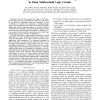Free Online Productivity Tools
i2Speak
i2Symbol
i2OCR
iTex2Img
iWeb2Print
iWeb2Shot
i2Type
iPdf2Split
iPdf2Merge
i2Bopomofo
i2Arabic
i2Style
i2Image
i2PDF
iLatex2Rtf
Sci2ools
ICCD
2008
IEEE
2008
IEEE
Analysis and minimization of practical energy in 45nm subthreshold logic circuits
Abstract— Over the last decade, the design of ultra-lowpower digital circuits in subthreshold regime has been driven by the quest for minimum energy per operation. In this contribution, we observe that operating at minimum-energy point is not straightforward as design constraints from real-life applications have an important impact on energy. Therefore, we introduce the alternative concept of practical energy, taking functional-yield and throughput constraints on minimum Vdd into account. In this context, we demonstrate for the first time the detrimental impact of DIBL on minimum Vdd. Practical energy gives a useful analysis framework of circuit optimization to reach minimum-energy point, while considering the throughput as an input variable dictated by the application. From simulation of a benchmark multiplier in 45nm technology, we find out that practical energy can be far higher than minimum energy point, in the case of lowthroughput applications (≈ 10-100 kOp/s) because of st...
| Added | 15 Mar 2010 |
| Updated | 15 Mar 2010 |
| Type | Conference |
| Year | 2008 |
| Where | ICCD |
| Authors | David Bol, Renaud Ambroise, Denis Flandre, Jean-Didier Legat |
Comments (0)

